- Home
- Crop Knowledge
- Vegetables
- Capsicum / Chilli
Capsicum / Chilli
- Nutrients
- Common Pests
- Crop Selection
- Documents
|
Crop Stage Images |
 |
 |
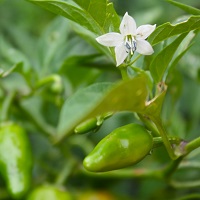 |
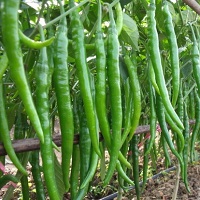 |
|
|---|---|---|---|---|---|
| Crop Stage | Transplanting to Plant Establishment stage | Flower Initiation to Flowering Stage | Flowering Set to Fruit Picking | Alternate Day From Picking | |
| Duration (in days) |
10 | 30 | 30 | 8 | |
|
Nutrients (Kg/ha) |
N | 11.98 | 47.94 | 35.95 | 23.94 |
| P | 4 | 8 | 4 | 3.81 | |
| K | 7.98 | 31.97 | 23.98 | 15.98 | |
Deficiency of Nutrients:
| Nutrients | Nitrogen (N) | Phosphorus (P) | Potassium (K) | Sulphur (S) | Calcium (Ca) |
|---|---|---|---|---|---|
| Nutrients Deficiency |  |
 |
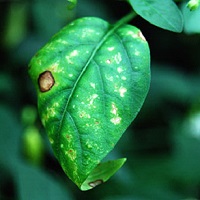 |
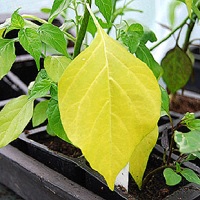 |
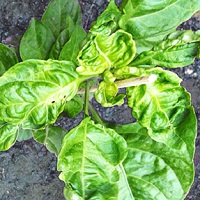 |
| Deficiency Symptoms | 1. Stunted growth.
2. Results in yellowing.
|
1. It is an essential component of many plant compounds.
2. Deficiency of phosphorus delays flowering and maturity. 3. Leaves are small and dark green. 4. Margins tend to curl upwards and inwards. |
1. Potassium is not lacking in the main chilli area.
2. Deficiency results in restricted plant growth. 3. Small reddish-brown spots develop on leaves. 4. These spots spread from the leaf tip. 5. Interveinal and marginal yellowing of the leaves may also develop in addition to spot. |
1. Growth is restricted. 2. Leaves turn pale yellow in colour. 3. New leaves become narrow and more pointed. |
1. Margins of young leaves become yellow. 2. Pale brown sunken areas develop on the fruit near the blossom end. 3. On less mature fruits, the whole of the distal end may be affected. |
| Nutrients | Magnesium (Mg) | Iron (Fe) | Copper (Cu) | Zinc (Zn) | Boron (B) |
|---|---|---|---|---|---|
| Nutrients Deficiency | 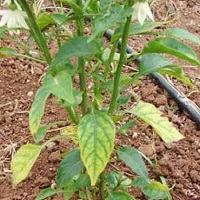 |
 |
 |
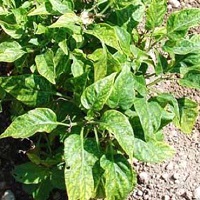 |
 |
| Deficiency Symptoms |
1. Young leaves become bright yellow-green and develop dark brown interveinal areas. 2. Small, white diffuse yellow areas develop on the mature leaves. 3. These may become brown later. 4. In severe cases leaves wither and drop off. |
1. Initially, iron deficiency results in interveinal chlorosis near the base of older leaves. If deficiency continues entire leaf including veins exhibits chlorotic symptoms. 2. The entire crop may exhibit bleached appearance, dry and finally die. |
1. Growth is restricted.
2. Plants remain dark green. 3. Leaf size is reduced. 4. Leaf margins tend to curl upwards. |
1. Deficiency symptoms first appear in newly formed leaves at 20 to 30 days of age. 2. Small purple areas develop which may turn brown. |
1. Yellowing on the tips of the mature leaves.
2. Spreads around margins. 3. The main veins become reddish, brown. 4. New leaves of young plants become distorted. |
| Images Of Disease: |  |
 |
|---|---|---|
| Damage Stage: | The disease affected leaves becomes small in size accompanied by downward curling.
The leaves may fall off in case of sever attack. The disease usually spreads through insect vectors such as thrips and aphids etc. |
|
Management (Pest Control):
| Chemical: | Control of insect vectors by spraying the crop with Dimethoate (Rogor -30 EC) or Monocrotophos (Monocil) @ 1 ml per litre of water indirectly helps to check the spread of this disease. |
|---|---|
| Organic: | Spray G Agro Microfeed L 5gm/lit + G Agro Meta 5ml/lit 2 to 3 spray at 21 days interval. Spray G Agro Tricho + G Agro Pseudo + G Agro Bacillus 5 ml/lit 2 to 3 spray at 21 days interval. |
| Images Of Disease: |  |
 |
|---|---|---|
| Damage Stage: | It is a serious disease of brinjal seedlings and mainly occurs in nursery bed.
The disease infected seedlings rot at ground level and then the plants fall over the ground. The seedlings die in patches. |
|
Management (Pest Control):
| Chemical: | The seeds should be treated without water (30 minutes at 520 C) or Cerasan or Agrosan G.N. before sowing of seed. The seedlings in the nursery should be sprayed with any fungicides at a regular interval. |
|---|---|
| Organic: | Spray G Agro Tricho 5gm/lit + G Agro Pseudo 5ml/lit 2 to 3 spray at 21 days interval. |
| Images Of Pest Life Cycle: |  |
 |
 |
 |
|---|---|---|---|---|
| Stages: | Egg | Larvae | Pupae | Adult |
| Mark Of Identification: | Are about 0.075mm long and 0.070 mm wide, and are inserted inside plant tissue.Eggs: Typically oval, whitish to yellowish coloured. | The larvae are off-white in colour. | Dark yellow with eyes and ocelli red pigmentation, wing buds are elongate. | Almost white on emergence, turning yellowish with incomplete dark stripes on the dorsal surface. |
| Life Cycle: | Eggs hatch in 4- 9 Days. | 4-6 Days. | 3-6 Days. | 10-15 Days. |
Management (Pest Control):
| Chemical: | At the time of transplanting in main fields deep the roots in Imidacloprid 10 ml or Carbosulfan 30 ml + Trichoderma 50 gms in 10 lits of water. |
|---|---|
| Organic: | Spray G Agro Microfeed L 5gm/lit + G Agro Meta 5ml/lit 2 to 3 spray at 21 days interval. G Agro Microfeed L 5gm/lit 2 to 3 spray at 21 days interval. |
| Images Of Pest Life Cycle: |  |
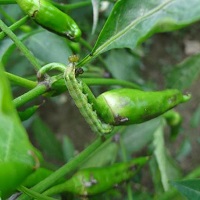 |
 |
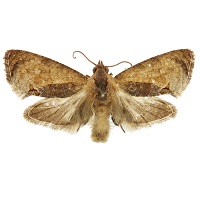 |
|---|---|---|---|---|
| Stages: | Egg | Larvae | Pupae | Adult |
| Mark Of Identification: | Spherical in shape and creamy white in color. | Varied colour. | Brown in colour, occurs in soil, leaf, pod and crop debris. | ‘V’ shaped speck on the light brownish fore wing and a dark border on the hind wings. |
| Life Cycle: | 2-5 Days. | 18-25 Days. | 10-12 Days. | 32-60 Days. |
Management (Pest Control):
| Chemical: | Spray Rynaxypyr 20 EC @ 0.25ml/lit or spinosad 45SC @ 0. 12 ml/lit or chlorpyriphos 20 EC @2.5ml/lit of water. B.t. product @ 500 g/lit or Carbaryl 50 WP @ 12. |
|---|---|
| Organic: | Spray G Agro Beau 5gm/lit + G Agro Meta 5ml/lit 2 to 3 spray at 21 days interval. |
| Seed Variety | Characteristics | Crop Duration (Days) |
Crop Yield (qtl/ha) |
|---|---|---|---|
| Agnirekha | Plants tall and spreading, fruits long, bold, smooth and light green in colour. | 180 | 250 |
| Musahvadi | 1. Plants are tall, spreading habit with dark green foliage. 2. Fruits are smooth and medium long. 3. It is tolerant to die back and wilt diseases |
180 | 19 (Dry Chilli) |
| Phule Jyoti | 1. Plants are tall with spreading and branching habit from ground level. 2. Leaves broad and dark green in colour. 3. Fruits are smooth, medium long, born in a cluster of 5-6 with a pendant habit. 4. It is tolerant to thrips, mites and wilt. |
170 | 250 |
| Phule Sai | 1. It has high yield potential under rainfed conditions. 2. It retains the colour in storage for 6-7 months. 3. It is moderately resistant to thrips and anthracnose. |
195-205 | 28.10 ton |
| Suryamukhi | 1. Fruits smooth, medium long, borne in a cluster of 5-6 and upright erect. 2. It is tolerant of thrips and wilt. |
210 | 190 |
| Phule Mukta | 1. Fruits are small, dark green and smooth. Ripe fruits are dark red in colour. 2. Resistant to powdery mildew and Fusarium wilt. 3. It is tolerant to leaf curl, thrips and mites and resistant to lodging. |
210 | 23 (Dry Chilli) |
| Jayanti | 1. It has been released for Vidarbha and at the national level under irrigated conditions. 2. Plants are medium to tall in height with light green foliage. |
180 | 18-20 (Dry Chilli) |
| Konkan Kranti | 1. Dark green fruits turn red when mature, mild pungent. 2. Fruits are dark green, lustrous, good keeping quality and good export potential. |
120-130 | 12-14 ton |

